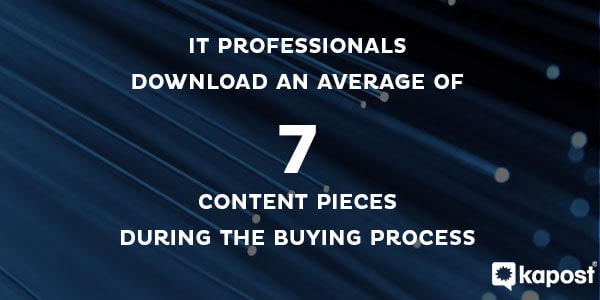Do you ever get the feeling that he’s just not listening? You know communication is important, but you’ve tried everything: eBooks, newsletters, perfectly written emails. Your sales team even followed up the same day he downloaded your latest white paper, and he brushed them off.
This relationship just isn’t working out—you’ll never get that CIO to invest in your solution.
Successful lead nurturing is like any relationship. It takes time, energy, and a lot of trial and error to get “inside the head” of the other party and learn how to communicate effectively.
Alternatively, it takes some good data. Sweet, fresh, in-depth data that answers your questions, inspires new ideas, and smacks you in the face with your own blind failings.

Think of it like The Rules, but for capturing the hearts of IT decision makers instead of eligible cave bachelors.
B2B tech marketers, we present to you that data.
IDG Enterprise—the media company that publishes CIO, Computerworld, CSO, DEMO, InfoWorld, ITworld, and Network World—recently released its 2014 Customer Engagement Study to find out what types of content IT decision makers typically want, expect, and use when considering new IT products and services.
What they found was that, in many cases, marketers are not only communicating poorly with IT pros; they’re speaking a different language altogether.

For IT decision makers, product demos and literature are one of the most universally important types of content, with 83% saying they relied on these during the buying process. Yet only a frighteningly low 26% of marketers are putting energy into providing those types of content. Because of communication gaps like this, 81% of IT decision makers say it’s challenging to locate enough high-quality information (high-quality being defined as credible and free of meaningless buzzwords) when they’re trying to make a purchasing decision.
How much information do they want? Actually, quite a bit. Turns out that IT pros download an average of seven content pieces during the buying process. They like that content to be geared toward their specific industry and, even more so, toward their job responsibilities.
Only after they’ve either downloaded about five content pieces or are six days into the process do they like to receive a call from the sales team. And they expect to keep receiving content for about three weeks in total.
In addition to reviews and product demos, there are a few types of content they trust:
- 76% like to read feature articles about the technology, while a very close 75% like to read feature articles about management trends and strategies
- 75% seek out case studies (marketers are doing much better on this one, with 65% reporting they create case studies)
- 73% look for analyst research (with only a sad 32% of marketers providing this)
- 71% use how-to content as a trusted resource
You’ll notice these content pieces trend toward the unbiased and objective rather than the salesy. That’s certainly worth keeping in mind when establishing your editorial voice.

Video content is also on the rise in level of importance:
- During the buying process, 88% of IT decision makers say they’ll watch a video, which is up from 80% just two years ago.
- Video leads to product research in 63% of cases and/or a vendor site visit in 54% of cases.
Finally, IDG’s research shows an interesting new way of looking at the buying process. While they want content to be relevant to their jobs and roles, IT decision makers are not terribly interested in being marketed to based on their stage in the process, with only 17% saying they like that type of targeting. The types of content they engage with at each stage of the process reflect this non-linear approach to content consumption. You’ll notice in the chart below that some of the same content being sought out in the early stages is used again later in the funnel.

If you’ve struggled to close deals based on the content you’re producing, this report includes plenty of helpful information, including stats on mobile expectations, social engagement, and search-result choices.
So before you give up on your CIO prospects, take a look at this report. You might have been communicating before now, but have you been putting out the right signals? It’s time to find out.
Find Out More on How You Drive Sales Through Content
Content marketing is a powerful tool for driving sales and revenue. See how in this in-depth eBook.


